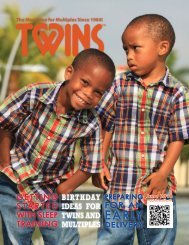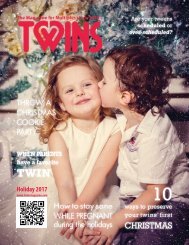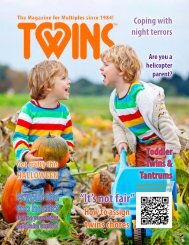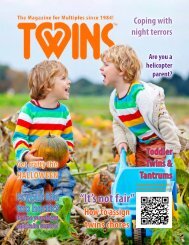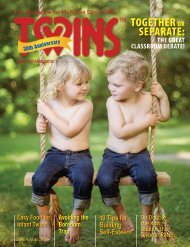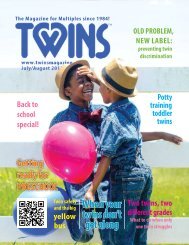TWINS - February 2018
You also want an ePaper? Increase the reach of your titles
YUMPU automatically turns print PDFs into web optimized ePapers that Google loves.
ering each of your children’s general attitudes about<br />
themselves. You can usually do this by watching for<br />
three specific behavior patterns:<br />
• How she ‘walks through her world’<br />
• What she says about herself<br />
• How she interacts with others<br />
How she ‘walks through her world’ — As a therapist,<br />
I learn a great deal about a child’s self-confidence by<br />
watching her enter the play therapy room, or ‘walk<br />
through her world.’ Of course, if it’s her first visit, she will<br />
be somewhat cautious as she enters, which is appropriate.<br />
Even the most self-confident people need to be<br />
cautious when they enter new situations; they need to<br />
be prepared to protect themselves if necessary.<br />
However, despite her caution, the self-confident child<br />
walks directly into the room rather than lingering in the<br />
hall, peeking in or resisting being brought in. She looks<br />
around her to see where she is and to find out what is in<br />
the room. If she sees something that she finds interesting,<br />
she moves nearer to it to view it more closely. She<br />
also stands straight rather than hunched in on herself.<br />
She makes no attempt to hide behind or under furniture,<br />
though she may stay fairly close to the wall or immediately<br />
sit in a chair. She walks looks and behaves like<br />
someone who feels OK about herself.<br />
What she says about herself — A younger unconfident<br />
child is often quite straightforward about describing<br />
how she feels about herself. She is likely to say things<br />
such as, “Oh! I’m always flubbing things up,” “I’m such a<br />
dummy because I only got 75% on my spelling test” or<br />
“They won’t want me to go. I can’t swim very well, and<br />
they know it.”<br />
By the middle years, though, especially the later<br />
middle years, the unconfident child may have stopped<br />
saying these things out loud, even though she still feels<br />
them inside. A middle-years child is more likely to say,<br />
“Everyone always accuses me of flubbing up,” “Spelling<br />
tests are stupid; no one needs to know all those words<br />
anyway” or “I hate swimming, so I don’t want to go.”<br />
How she interacts with others — A self-confident child<br />
can play happily with other children at least some of the<br />
time. She can, most of the time, resist pressure to do<br />
things she knows are wrong, and she can often defend<br />
herself and others against bullying. Her relationships<br />
are not necessarily always happy; she can get angry and<br />
fight when she feels put upon.<br />
Even if her personality is more retiring and she tends<br />
to follow rather than lead, she will not usually follow<br />
others into trouble or be led to be “bad”. She may enjoy<br />
A <strong>TWINS</strong> Magazine<br />
solitary activities, but she will have close friends and<br />
enjoy spending time with them. She does not act upset<br />
if left out of an activity, though she may need some help<br />
in restoring relationships every now and then.<br />
THE EBB AND FLOW OF SELF-CONFIDENCE<br />
It is important to remember that just as your own level<br />
of self-confidence may vary depending upon your mood<br />
and the situation, so will each of your children’s. A child<br />
who shows every sign of feeling OK about her own self<br />
this week may suddenly withdraw, talk down about herself<br />
and walk around looking unhappy next week.<br />
Your careful and supportive questioning of your child<br />
can often help you discover if there is a real problem<br />
that your child feels is too difficult for her to handle;<br />
in many cases, that feeling may be undermining her<br />
self-confidence. In addition, a bully, an unexpected low<br />
grade on a test, a teacher whose standards are unrealistic<br />
for a child or a parent who is tense and irritable<br />
because of problems at work can temporarily affect a<br />
child’s self-confidence. When assessing each of your<br />
children’s level of self-confidence, consider whether your<br />
child displays self-confidence more often than not.<br />
THE TWIN FACTOR<br />
As you consider the self-confidence of your middle-years<br />
twins, you may discover that one of them displays more<br />
self-confidence than the other. As you may have observed,<br />
it is not uncommon for one child to assume the<br />
leadership role in a twinship. For the most part, this kind<br />
of difference between co-twins seems to reflect personality<br />
differences more than it reflects their levels of<br />
self-confidence.<br />
However, it is possible for one twin to have developed<br />
more self-confidence than her co-twin, perhaps<br />
because of her leadership ability. When one twin always<br />
leads, it is possible for her co-twin to think to herself, “I<br />
can’t do that. It’s a good thing she can.”<br />
If you notice that your twins’ natural leader/follower<br />
roles are affecting their selfconfidence, it is important to<br />
try to make some changes. For example, you may need<br />
to create ways for the follower to have more opportunities<br />
to lead or to have some successes on her own so<br />
that they can’t be ascribed to her co-twin.<br />
You may also notice that your twins have different<br />
ways in which they express their self-confidence. Your<br />
child who gets things accomplished quietly and steadily<br />
may be just as confident as her co-twin who accomplishes<br />
tasks in a loud and somewhat cocky manner. In fact,<br />
it’s quite possible that a child’s display of cockiness may<br />
actually be a cover-up for his lack of confidence. A<br />
<strong>February</strong> <strong>2018</strong> 25







